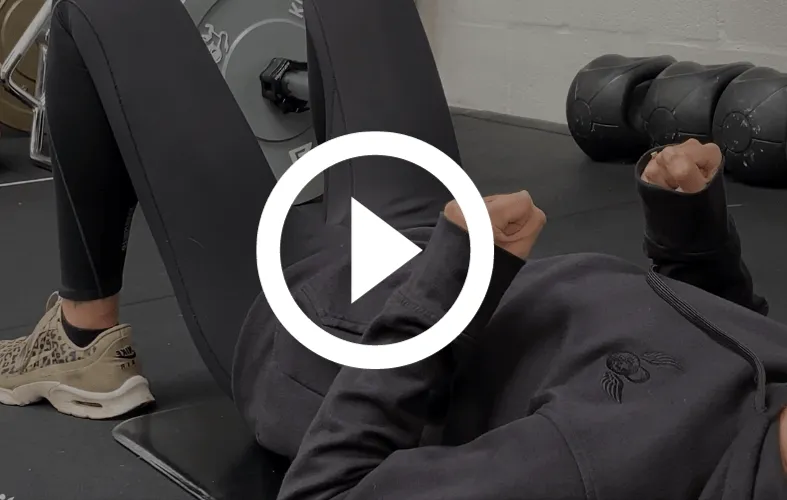
Share this page with friends
How to build a strong pelvic floor and why it's important
The pelvic floor is a bit of a strange one. It’s a super important muscle group for aging well, but it’s totally invisible. Unfortunately, this means it’s often overlooked until a problem arises. In this article, we’ll explore why it’s essential to build a strong pelvic floor and how you can build a strong pelvic floor at home.
Building and maintaining a strong pelvic floor doesn’t require an expensive gym membership. You don’t need to go to the sports shop and buy a fancy new pair of trainers. You don’t need to huff and puff or sweat your butt off for an hour a day. But, you do need some space at home to lie down and a small helping of know-how.
First things first, you need to know what the pelvic floor is.
Understanding the pelvic floor
The pelvic floor makes up a group of muscles that form a hammock-like structure at the base of your pelvis. Your pelvic floor has several vital functions: It supports organs like your bladder, uterus, and rectum, while also maintaining continence, and providing stability to your spine and pelvis. Not bad huh?
Building a strong pelvic floor
So, now that you understand a bit more about the pelvic floor. Let’s take a look at how you go about building yourself a pelvic floor to be proud of. We brought in Natalie Small, Personal Trainer, and postpartum specialist to talk through some exercises and their benefits. Grab yourself a cup of tea, sit back, relax, and watch the video below.

We spoke to Dr Kristal Lau, Postpartum Wellness Consultant. She shares with us some of the benefits of performing pelvic floor exercises that are sure to improve your quality of life!
"Improved self-esteem and self-confidence: Stronger pelvic floors can help with reducing urinary leakage events. Knowing that you’re less likely to experience these can help with boosting your self-esteem and self-confidence as you go about your everyday activities.
Improved sexual experience: The pelvic floor supports the sexual organs for both women and men. Having a stronger pelvic floor can help you enjoy sex better. For some women, this can also help with less painful sex.
Return to enjoying your favourite activities! Usually, building a strong pelvic floor is done alongside building the core abdominal muscles. This is because the core muscles play a part in supporting the pelvic floor. This means having both groups of muscles strong together can help with reducing back pain in some people. And best all, you’ll feel stronger overall and have more confidence to return to doing physical activities you enjoy! These include dancing, hiking, gardening, and playing with your children or grandchildren."
Importance of pelvic floor health
1. Reduce your risk of developing incontinence
One of the primary functions of the pelvic floor is controlling the release of your poo and wee. Weak pelvic floor muscles can lead to leakage when sneezing, coughing, or even laughing. Similarly, fecal incontinence, although less talked about, can also result from pelvic floor weakness. Building and maintaining a strong pelvic floor not only reduces your risk of developing incontinence, but it’ll also help you regain control if you’re already incontinent.
2. Pregnancy and postpartum health
This one’s just for the females. During pregnancy, your body undergoes big changes. During this time, the pelvic floor experiences added stress. Strong pelvic floor muscles can help support a growing uterus, reducing the risk of complications like pelvic organ prolapse. Strengthening these muscles after giving birth helps with recovery and helps to prevent long-term issues, such as stress urinary incontinence. You can read all about postpartum leakage here.
3. Preventing prolapse
You know earlier on when we mentioned the pelvic floor supports a bunch of organs? Well, your pelvic floor prevents them from descending or prolapsing into the vaginal or rectal area. Organ prolapse can cause discomfort, pain, and the need for surgical intervention.
4. Back and pelvic stability
Beyond maintaining continence and keeping your organs in place, a robust pelvic floor can contribute to overall body stability. These muscles work with the abdominal and back muscles to support the spine and pelvis. A weak pelvic floor can lead to issues like lower back pain and pelvic instability, affecting your mobility and quality of life.

Maintaining a strong pelvic floor
In addition to the exercises outlined in our video, positive lifestyle choices can help maintain pelvic floor health. Keeping a healthy weight and avoiding smoking can reduce the risk of weakening these muscles. Smoking and the coughing it causes can put added pressure on the pelvic floor, leading to muscle damage over time. The Guardian recommends:
- Keep up with the pelvic floor exercises
- Download an app such as the NHS Squeezy app
- Maintain a healthy weight
- Learn to lift heavy weights and objects correctly
- Take up pilates





